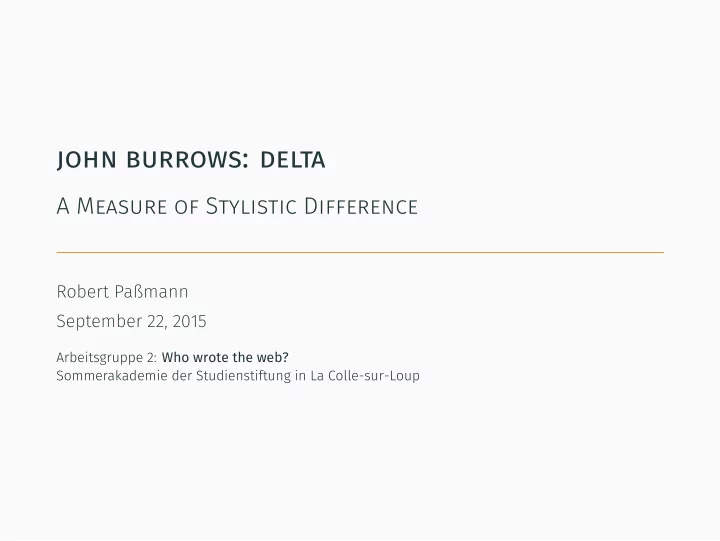

john burrows: delta A Measure of Stylistic Difference Robert Paßmann September 22, 2015 Arbeitsgruppe 2: Who wrote the web? Sommerakademie der Studienstiftung in La Colle-sur-Loup
table of contents 1. The Delta Procedure 2. Reproducing the Approach 3. Conclusion 2
the delta procedure
in easy words... We have a database of authors with some of their texts a sample text of unknown authorship We want to order the authors by likelihood of authorship • Therefore, measure the difference of a sample text and an author by a single value – Delta . • The most likely author will be the one with the least delta. 4
how does it work? an example J. F. Burrows, “Delta: a measure of stylistic difference and a guide to likely authorship”, Literary and Linguistic Computing 17, pp. 267–287, 2002a. 5
how does it work? 1. For every text in the database, calculate the relative frequency or scores f t i ( w ) of every (tagged) word w in the text. 2. Calculate the means µ a i ( w ) , µ ( w ) and standard deviations σ a i ( w ) , σ ( w ) of the scores with respect to authors ( a i ) and the whole database. 3. Calculate the z-scores for every word of every author in the database: z a i ( w ) = µ a i ( w ) − µ ( w ) σ ( w ) 4. For the sample text s , calculate the mean frequencies f s ( w ) and their z-scores with respect to the mean frequencies in the whole database. 5. Calculate the delta for every author as: 1 ∑ ∆ s ( a i ) = | z s ( w ) − z a i ( w ) | | M | w ∈ M 6. Finally, compare the deltas of the different authors. 6
experiments and results Burrows tested the method as follows: • Using a main database of 25 english authors of the late seventeenth century • He tested 200 english poems of 15 authors • 12 of 15 authors are in the database • no poem is contained in the database His observations were: • The delta method works better than expected • It works for closed- and open-class problems • Great method for reducing the field of likely candidates • It works best for longer texts ( > 1500 words) • The method might fail for texts which are uncharacteristic for their authors or are far separated in time 7
experiments and results (ii) J. F. Burrows, “Delta: a measure of stylistic difference and a guide to likely authorship”, Literary and Linguistic Computing 17, pp. 267–287, 2002a. 8
experiments and results (iii) J. F. Burrows, “Delta: a measure of stylistic difference and a guide to likely authorship”, Literary and Linguistic Computing 17, pp. 267–287, 2002a. 9
reproducing the approach
an implementation of the delta method • Implemented in Python 3.4 • Using NLTK library for tagging • Algorithm is implemented in three classes • Every Text is written by an Author of our Database • These classes have methods to perform the calculations 11
problems during reproduction • What does the main database consist of? PAN12 • When do the deltas indicate that there is too less difference such that further investigation is needed? 12
results (i) 13
results (ii) 14
problems during reproduction • What does the main database consist of? PAN12 • When do the deltas indicate that there is too less difference such that further investigation is needed? 15
let’s have a closer look... • test cases 4, 6, 8 and 10 are not of authors from the database • with a threshold at 1 . 10, we have a success rate of 8 / 10 16
an idea to solve the open-class problems • choose a reasonable threshold x • normalize all deltas with respect to the minimum delta value, i.e. δ i = ∆ s ( a i ) ∆ min • if there is no i with δ i ∈ [ 1 , x ) then output a i • otherwise further investigation is needed (output none ) 17
results of the open-class problems (i) 18
results of the open-class problems (ii) 19
conclusion
conclusions Regarding the Delta method and the tests with PAN12 data • Delta works good to reduce large sets of possible authors • Sometimes Delta has no clue Regarding Burrow’s paper, i.e. the reproduction • It was not possible to reproduce Burrow’s example because of missing information (How did he form his database?) • It was necessary to find a way to deal with open-class problems • It can be confirmed that Delta is useful for reducing the set of possible authors 21
Recommend
More recommend